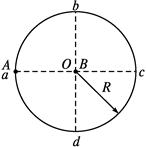问题
计算题
(13分)如图所示,在同一竖直平面内有A、B两物体,A物体从a点起以角速度ω沿顺时针方向做半径为R的匀速圆周运动,同时B物体从圆心O处自由下落.若要A、B两物体在d点相遇,求角速度ω须满足的条件.

答案
ω= π
π  (其中n=0,1,2……)
(其中n=0,1,2……)
A物体到达d点的时间
tA= T=
T=
 (其中n=0,1,2……)
(其中n=0,1,2……)
B物体到达d点的时间tB= ,tA=tB,
,tA=tB,
 =
= ,
,
解得ω= π
π  (其中n=0,1,2……).
(其中n=0,1,2……).
